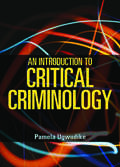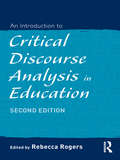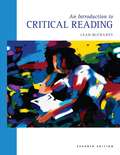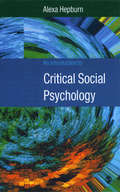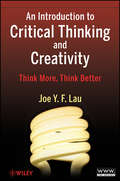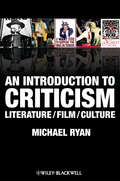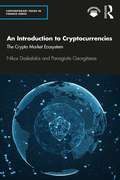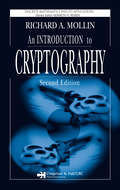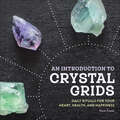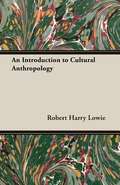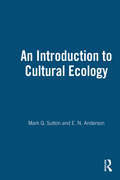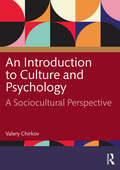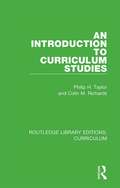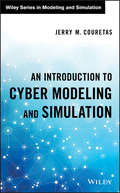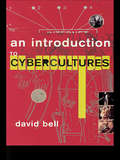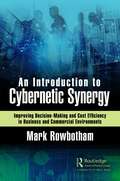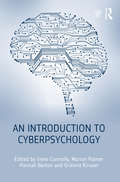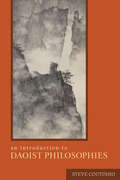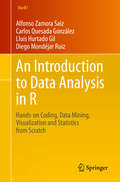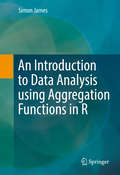- Table View
- List View
An Introduction to Critical Criminology
by Pamela UgwudikeCritical criminological theories and perspectives are typically major components of Criminology degree courses. An Introduction to Critical Criminology is the first accessible text on these topics for students of criminology, sociology and social policy. Written by an experienced lecturer who specialises in the topic, it offers an in-depth but accessible introduction to foundational and contemporary theories and perspectives in critical criminology. In doing so, it introduces students to theories and perspectives that challenge mainstream criminological theories about the causes of crime, and the operation of the criminal justice system. With the inclusion of boxed examples, key points and sample essay questions An Introduction to Critical Criminology is ideal for students of Criminology because it explores in detail a vast array of critical criminological theories and perspectives.
An Introduction to Critical Discourse Analysis in Education
by Rebecca RogersAccessible yet theoretically rich, this landmark text introduces key concepts and issues in critical discourse analysis and situates these within the field of educational research. The book invites readers to consider the theories and methods of three major traditions in critical discourse studies – discourse analysis, critical discourse analysis, and multimodal discourse analysis -- through the empirical work of leading scholars in the field. Beyond providing a useful overview, it contextualizes CDA in a wide range of learning environments and identifies how CDA can shed new insights on learning and social change. Detailed analytic procedures are included – to demystify the process of conducting CDA, to invite conversations about issues of trustworthiness of interpretations and their value to educational contexts, and to encourage researchers to build on the scholarship in critical discourse studies. This edition features a new structure; a touchstone chapter in each section by a recognized expert (Gee, Fairclough, Kress); and a stronger international focus on both theories and methods. NEW! Companion Website with Chapter Extensions; Interviews; Bibliographies; and Resources for Teaching Critical Discourse Analysis.
An Introduction to Critical Management Research
by Mihaela L. Kelemen Nick Rumens`This book offers a lively and readable account of how scholars and students might engage with some of the more unusual critical theories associated with the critical management research project. Supported by a wealth of empirical and theoretical material, this book will introduce readers to the complex issues surrounding how to carry out critical management research rather than simply providing prescriptive answers' - Heather Höpfl, University of Essex `Kelemen and Rumens have done management scholars a great service in reviewing a huge amount of disparate knowledge and compressing it into a succinct, lively and provocative book on the current state of Critical Management Studies. This is a "must-read" for those both inside and outside CMS' - Keith Grint, Cranfield University `Management is a critical term for contemporary politics, but getting to grips with managerialism requires research methods that can deal with contemporary and controversial topics. This book provides the tools for that project, and will be invaluable for scholars and students who wish to challenge the conservatism of management academy at the present time' - Martin Parker, University of Leicester Why have certain theories shaped management research? Where do research theory and practice meet, if at all? To ask these questions is to think critically about management research. Mihaela L Kelemen and Nick Rumens explore the fundamentals of critical management theory and their influences on management research, and in doing so offer the student an illuminating introduction to what is often a disparate and complex array of issues. 10 expressive chapters examine theoretical foundations, including those most often sidelined in mainstream management theory; from postmodernism and deconstruction to American pragmatism, along with methodological choices and the intellectual issues each of these presents. Also provided is a timely consideration to the consequences and ethical concerns now inherent to any research issue.
An Introduction to Critical Reading
by Leah MccraneyThis unique college reading text gives students experience reading and evaluating poetry, short stories, essays, and textbook chapters. An innovative Instructor's Manual gives instructors a wealth of teaching ideas and background material on each piece with a focus on critical thinking.
An Introduction to Critical Social Psychology
by Dr Alexa Hepburn'this book provides an excellent introduction to contemporary Critical Social Psychology, which anyone exploring the field would do well to read.' - Psychology in Society 'a very accessible introduction... lively and engaging.... Discussion questions are uncharacteristicaly thought-provoking, while practical exercises also seem better considered than one comes to expect from similar primers, suggesting a successful future as a core text in social psychology courses' - The Psychologist 'Erudition, sagacity, patience and scholarship radiate from this book. This is an excellent introduction to the various strands of critical thinking to emanate primarily from England, and, to some extent, from continental Europe. Anyone interested in learning more about the discursive side of critical psychology will find in this book an excellent guide. I recommend this book to all psychologists interested in critical perspectives' - Journal of Community and Applied Psychology A critical approach depends on a range of often-implicit theories of society, knowledge, as well as the subject. This book shows the crucial role of these theories for directing critique at different parts of society, suggesting alternative ways of doing research, and effecting social change. It includes chapters from the perspectives of social cognition, Marxism, psychoanalysis, discourse and rhetoric, feminism, subjectivity and postmodernism. In each case, the strengths and weaknesses of each perspective are highlighted, the ideas are linked to real world issues by a range of practical exercises, and guidance is given to further reading.These chapters will cover the work of diverse thinkers from within social psychology, such as Billig, Gergen, Kitzinger, Parker, Potter, Shotter, Walkerdine and Wetherell, and from outside, such as Butler, Derrida, Foucault, Haraway, Lyotard, Marx and Rose. An Introduction to Critical Social Psychology provides a systematic, integrated and accessible introduction to social psychology as a critical discipline. Consequently, it will be key reading for undergraduates and postgraduates studying Critical Social Psychology, and useful additional reading for postgraduates studying theoretical psychology and qualitative methods.
An Introduction to Critical Thinking and Creativity
by Joe Y. F. LauA valuable guide on creativity and critical thinking to improve reasoning and decision-making skills Critical thinking skills are essential in virtually any field of study or practice where individuals need to communicate ideas, make decisions, and analyze and solve problems. An Introduction to Critical Thinking and Creativity: Think More, Think Better outlines the necessary tools for readers to become critical as well as creative thinkers. By gaining a practical and solid foundation in the basic principles that underlie critical thinking and creativity, readers will become equipped to think in a more systematic, logical, and imaginative manner. Creativity is needed to generate new ideas to solve problems, and critical thinking evaluates and improves an idea. These concepts are uniquely introduced as a unified whole due to their dependence on each other. Each chapter introduces relevant theories in conjunction with real-life examples and findings from cognitive science and psychology to illustrate how the theories can be applied in numerous fields and careers. An emphasis on how theoretical principles of reasoning can be practical and useful in everyday life is featured, and special sections on presentation techniques, the analysis of meaning, decision-making, and reasoning about personal and moral values are also highlighted. All chapters conclude with a set of exercises, and detailed solutions are provided at the end of the book. A companion website features online tutorials that further explore topics including meaning analysis, argument analysis, logic, statistics, and strategic thinking, along with additional exercises and multimedia resources for continued study. An Introduction to Critical Thinking and Creativity is an excellent book for courses on critical thinking and logic at the undergraduate and graduate levels. The book also serves as a self-contained study guide for readers interested in the topics of critical thinking and creativity as a unified whole.
An Introduction to Criticism
by Michael RyanAn accessible and thorough introduction to literary theory and contemporary critical practice, this book is an essential resource for beginning students of literary criticism.Covers traditional approaches such as formalism and structuralism, as well as more recent developments in criticism such as evolutionary theory, cognitive studies, ethical criticism, and ecocriticismOffers explanations of key works and major ideas in literary criticism and suggests key elements to look for in a literary textAlso applies critical approaches to various examples from film studiesHelps students to build a critical framework and write analytically
An Introduction to Cryptocurrencies: The Crypto Market Ecosystem (Contemporary Issues in Finance)
by Nikos Daskalakis Panagiotis GeorgitseasThe Crypto Market Ecosystem has emerged as the most profound application of blockchain technology in finance. This textbook adopts an integrated approach, linking traditional functions of the current financial system (payments, traded assets, fundraising, regulation) with the respective functions in the crypto market, in order to facilitate the reader in their understanding of how this new ecosystem works. The book walks the reader through the main features of the blockchain technology, the definitions, classifications, and distinct characteristics of cryptocurrencies and tokens, how these are evaluated, how funds are raised in the cryptocurrency ecosystem (ICOs), and what the main regulatory approaches are. The authors have compiled more than 100 sources from different sub-fields of economics, finance, and regulation to create a coherent textbook that provides the reader with a clear and easily understandable picture of the new world of encrypted finance and its applications. The book is primarily aimed at business and finance students, who already have an understanding of the basic principles of how the financial system works, but also targets a more general readership, by virtue of its broader scope and engaging and accessible tone.
An Introduction to Cryptography (Discrete Mathematics and Its Applications)
by Richard A. MollinContinuing a bestselling tradition, An Introduction to Cryptography, Second Edition provides a solid foundation in cryptographic concepts that features all of the requisite background material on number theory and algorithmic complexity as well as a historical look at the field.With numerous additions and restructured material, this edition
An Introduction to Crystal Grids: Daily Rituals for Your Heart, Health, and Happiness
by Karen FrazierHealing the mind, body, and sacred spirit—a beginner's guide to the power of crystal grids.A small symphony of crystals energized in complete harmony—that's a crystal grid. A single gemstone sets the tone. Add more crystals and sacred geometry brings shape and structure to amplify and harness the ultimate power of your grid. An Introduction to Crystal Grids is the perfect guide for beginners to manifest your intentions and get on the path to positive energy, healing, and wellness.Start your gemstone journey with powerful crystals—then build your skills grid-by-grid so that the collective crystal energy can deliver the change you desire. From the simplest shape (a single circle) to the most complex configuration (flower of life), An Introduction to Crystal Grids gives you the insights and information to achieve your desired manifestation—from aura cleansing to cultivating a work ethic.This essential handbook on crafting crystal grids includes:Get crystal clear—Discover 25 essential crystals—from amber to turquoise—and their healing properties in this quick crystal grids reference guide.Sacred shapes—Explore fundamental forms, sacred geometry, and 15 basic grid shapes like a spiral, a sunburst, a triangle, and beyond.Manifest positivity—Build crystal grids step-by-step that enrich the five modes of life—health, spirituality, career, relationships, and learning.Learn how to release the awesome healing power of crystals grids in your everyday life.
An Introduction to Cultural Ecology
by Mark Q. Sutton E. N. AndersonThis contemporary introduction to the principles and research base of cultural ecology is the ideal textbook for advanced undergraduate and beginning graduate courses that deal with the intersection of humans and the environment in traditional societies. After introducing the basic principles of cultural anthropology, environmental studies, and human biological adaptations to the environment, the book provides a thorough discussion of the history of, and theoretical basis behind, cultural ecology. The bulk of the book outlines the broad economic strategies used by traditional cultures: hunting/gathering, horticulture, pastoralism, and agriculture. Fully explicated with cases, illustrations, and charts on topics as diverse as salmon ceremonies among Northwest Indians, contemporary Maya agriculture, and the sacred groves in southern China, this book gives a global view of these strategies. An important emphasis in this text is on the nature of contemporary ecological issues, how peoples worldwide adapt to them, and what the Western world can learn from their experiences. A perfect text for courses in anthropology, environmental studies, and sociology.
An Introduction to Culture and Psychology: A Sociocultural Perspective
by Valery ChirkovThe book offers an innovative introduction to culture and psychology, taking a sociocultural perspective to understand the complexities of culture-mind-behaviour interactions.In this book, the author emphasizes the dynamic relationship of the culture and the mind, outlining how organized sociocultural models regulate actions and practices across different domains of people’s lives, such as parenting, education, communication, and acculturation. Each chapter features chapter synopsis, boxed examples, a glossary of key terms, reflective questions, and recommended reading to help students engage further with the material. The book includes a range of cross-cultural case study examples and discussions which offer insights into the connections between culture, human psyche, and behaviour.An Introduction to Culture and Psychology is essential reading for undergraduate students taking culture and psychology courses. It can also be of interest to students and young scholars of psychology, anthropology, sociology, communication, and other related disciplines.
An Introduction to Curriculum Studies (Routledge Library Editions: Curriculum #34)
by Philip H. Taylor Colin M. RichardsOriginally published in 1979 with a second edition in 1985. A basic text for students of education and teachers who are coming to terms for the first time with the nature of the curriculum. It introduces the reader to the professional field that is of concern to all engaged in the practical enterprise of education in a way which provides a ‘feel’ for the preoccupations of the area and a ‘sense’ of its complexities. With annotated further reading included, the book reflects developments in all the major areas in curriculum design and evaluation and in effecting curriculum change, plus research and theory.
An Introduction to Cyber Analysis and Targeting
by Jerry M. CouretasThis book provides a comprehensive view of cyber operations, analysis and targeting, including operational examples viewed through a lens of conceptual models available in current technical and policy literature. Readers will gain a better understanding of how the current cyber environment developed, as well as how to describe it for future defense. The author describes cyber analysis first as a conceptual model, based on well-known operations that span from media to suspected critical infrastructure threats. He then treats the topic as an analytical problem, approached through subject matter interviews, case studies and modeled examples that provide the reader with a framework for the problem, developing metrics and proposing realistic courses of action. Provides first book to offer comprehensive coverage of cyber operations, analysis and targeting;Pulls together the various threads that make up current cyber issues, including information operations to confidentiality, integrity and availability attacks;Uses a graphical, model based, approach to describe as a coherent whole the development of cyber operations policy and leverage frameworks;Provides a method for contextualizing and understanding cyber operations.
An Introduction to Cyber Modeling and Simulation (Wiley Series in Modeling and Simulation #88)
by Jerry M. CouretasIntroduces readers to the field of cyber modeling and simulation and examines current developments in the US and internationally This book provides an overview of cyber modeling and simulation (M&S) developments. Using scenarios, courses of action (COAs), and current M&S and simulation environments, the author presents the overall information assurance process, incorporating the people, policies, processes, and technologies currently available in the field. The author ties up the various threads that currently compose cyber M&S into a coherent view of what is measurable, simulative, and usable in order to evaluate systems for assured operation. An Introduction to Cyber Modeling and Simulation provides the reader with examples of tools and technologies currently available for performing cyber modeling and simulation. It examines how decision-making processes may benefit from M&S in cyber defense. It also examines example emulators, simulators and their potential combination. The book also takes a look at corresponding verification and validation (V&V) processes, which provide the operational community with confidence in knowing that cyber models represent the real world. This book: Explores the role of cyber M&S in decision making Provides a method for contextualizing and understanding cyber risk Shows how concepts such the Risk Management Framework (RMF) leverage multiple processes and policies into a coherent whole Evaluates standards for pure IT operations, "cyber for cyber," and operational/mission cyber evaluations—"cyber for others" Develops a method for estimating both the vulnerability of the system (i.e., time to exploit) and provides an approach for mitigating risk via policy, training, and technology alternatives Uses a model-based approach An Introduction to Cyber Modeling and Simulation is a must read for all technical professionals and students wishing to expand their knowledge of cyber M&S for future professional work.
An Introduction to Cybercultures
by David BellAn Introduction to Cybercultures provides an accessible guide to the major forms, practices and meanings of this rapidly-growing field. From the evolution of hardware and software to the emergence of cyberpunk film and fiction, David Bell introduces readers to the key aspects of cyberculture, including email, the internet, digital imaging technologies, computer games and digital special effects. Each chapter contains `hot links' to key articles in its companion volume, The Cybercultures Reader, suggestions for further reading, and details of relevant websites. Individual chapters examine: · Cybercultures: an introduction · Storying cyberspace · Cultural Studies in cyberspace · Community and cyberculture · Identities in cyberculture · Bodies in cyberculture · Cybersubcultures · Researching cybercultures
An Introduction to Cybernetic Synergy: Improving Decision-Making and Cost Efficiency in Business and Commercial Environments
by Mark RowbothamCybernetics is about having a goal and taking action to achieve that goal. Knowing whether you have reached your goal (or at least are getting closer to it) requires “feedback”, a concept that was made rigorous by cybernetics. The subject of Cybernetic Synergy, although emanating from a socio-economic experiment of economic control by cybernetic means in Chile in the early 1970s, has never been approached as an applied subject in its own right. Indeed, the subject of applied cybernetics has never been addressed as a separate issue, although it has been shown that the overall subject of cybernetics applies to a wide range of disciplines, from biology to business via mathematics and engineering. Cybernetic synergy is the study of relationships and controls of and between corporate entities, on an external basis, and departments within corporate entities, on an internal basis. It concerns the decision-making process, and how decisions can be made based on feedback from any part of the organization being managed. It therefore concerns the issue of input of raw material or information, the output of the transformed information and materials, and the rectification of any issue based on negative feedback related to the productive process. It investigates not only the basic theory of the subject but also its applications in the commercial and business environment, as well as touching on government and administrative issues where shortcomings have emerged owing to a lack of synergy and communication. There are already several books available on the subject to cybernetics, but they are all concerned with mathematical approaches along with very heavy technical texts, most of which are completely alien to the layman or the simple practitioner. Furthermore, other than references to business or economic practice in some books, there has never been a book published purely about the subject of applied cybernetics relating to business practices. The book covers the subjects of management and economic cybernetics, and how the theory of cybernetic control can be used to manage business and government functions, whether small, medium or large. It looks at the history of cybernetics, and how some pioneering cybernetic concepts were used in Chile in the early 1970s to manage the Chilean economy. It uses these same principles, along with later cybernetic models, to show how such concepts can be applied to the present-day economy and business practices. It examines present-day business practices and shows how weaknesses in these systems can be addressed and eliminated by the application of cybernetic practices. The aims of the book are to provide an insight into the subject of management and business cybernetics, using the principle of cybernetic synergy, to resolve intra-corporate issues and create more efficient business practices based on simple command-and-control processes. Essentially, this book provides an in-depth insight into the use of cybernetics in business and administration environments, and would explain how cybernetics is a valuable tool in resolving corporate issues concerning efficiency and overall control. It would give a detailed explanation of the various practices and functions involved in business operations and practices.
An Introduction to Cyberpsychology
by Irene Connolly, Palmer Marion, Barton Hannah and Kirwan GráinneAn Introduction to Cyberpsychology is the first book to provide a student-oriented introduction to this rapidly growing and increasingly studied topic. It is designed to encourage students to critically evaluate the psychology of online interactions, and to develop appropriate research methodologies to complete their own work in this field. The book is comprised of four main sections: An overview of cyberpsychology and online research methodologies Social psychology in an online context The practical applications of cyberpsychology The psychological aspects of other technologies. Each chapter includes: Explanations of key terms and a glossary to facilitate understanding Content summaries to aid student learning Activity boxes, discussion questions and recommended reading to guide further study. Further resources for students and instructors are available on the book’s companion website, including audio and video links, essay questions, a multiple-choice test bank, and PowerPoint lecture slides. Uniquely combining a survey of the field with a focus on the applied areas of psychology, the book is designed to be a core text for undergraduate modules in cyberpsychology and the psychology of the internet, and a primer for students of postgraduate programs in cyberpsychology.
An Introduction to Cyberpsychology (BPS Core Textbooks Series)
by Gráinne Kirwan, Irene Connolly, Hannah Barton, and Marion PalmerAn Introduction to Cyberpsychology provides a comprehensive introduction to this rapidly growing discipline. Fully updated in its second edition, the book encourages students to critically evaluate the psychology of online interactions and to develop appropriate research methodologies to complete their own work in this field.The book examines cyberpsychology and online research methodologies, social psychology in an online context, practical applications of cyberpsychology, and the psychological aspects of other technologies. This new edition has been carefully updated to include additional coverage of: Expanded content relating to major developments in the field and new content on gaming and screentime A new chapter examining the relationship between older adults and technology Cyberpsychology in focus feature boxes in each chapter that examine topics in depth Interviews with professionals working in fields relating to cyberpsychology Each chapter includes key terms and a glossary, content summaries, discussion questions, and recommended reading to guide further study.Supported by extensive online resources for students and instructors, this authoritative book is an essential core text for undergraduate modules in cyberpsychology, and an ideal primer for students of postgraduate programs in cyberpsychology.To view the additional student and instructor resources for this book, please visit bpscoretextbooks.routledge.com
An Introduction to Daoist Philosophies
by Steve CoutinhoSteve Coutinho explores in detail the fundamental concepts of Daoist thought as represented in three early texts: the Laozi, the Zhuangzi, and the Liezi. Readers interested in philosophy yet unfamiliar with Daoism will gain a comprehensive understanding of these works from this analysis, and readers fascinated by ancient China who also wish to grasp its philosophical foundations will appreciate the clarity and depth of Coutinho's explanations.Coutinho writes a volume for all readers, whether or not they have a background in philosophy or Chinese studies. A work of comparative philosophy, this volume also integrates the concepts and methods of contemporary philosophical discourse into a discussion of early Chinese thought. The resulting dialogue relates ancient Chinese thought to contemporary philosophical issues and uses modern Western ideas and approaches to throw new interpretive light on classical texts. Rather than function as historical curiosities, these works act as living philosophies in conversation with contemporary thought and experience. Coutinho respects the multiplicity of Daoist philosophies while also revealing a distinctive philosophical sensibility, and he provides clear explanations of these complex texts without resorting to oversimplification.
An Introduction to Daoist Thought: Action, Language, and Ethics in Zhuangzi
by Eske MøllgaardThis is the first work available in English which addresses Zhuangzi’s thought as a whole. It presents an interpretation of the Zhuangzi, a book in thirty-three chapters that is the most important collection of Daoist texts in early China. The author introduces a complex reading that shows the unity of Zhuangzi’s thought, in particular in his views of action, language, and ethics. By addressing methodological questions that arise in reading Zhuangzi, a hermeneutics is developed which makes understanding Zhuangzi’s religious thought possible. A theoretical contribution to comparative philosophy and the cross-cultural study of religious traditions, the book serves as an introduction to Daoism for graduate students in religion, philosophy, and East Asian Studies.
An Introduction to Data Analysis Using IBM SPSS
by Lokesh JasraiThis textbook elaborates on the basic understanding and application of statistical tests and data analysis using hypothetical datasets and SPSS version 22.0. It presents step-by-step processes and to-the-point interpretation for quick assimilation and comprehension.Data Analysis Using SPSS Begins with the stages of data entry and goes on till editing and data visualization. Takes the readers through descriptive statistics, frequency, univariate, bivariate and regression analysis, cross-tabulation, linear models and non-parametric test procedures. Presents information through dialog boxes and tabular charts, and also incorporates important formulae, calculations and illustrations of sample data for an in-depth understanding of concepts and results. Can be used as a textbook as well as a reference book as it helps to build conceptual understanding, gaining software skills, and communicates data and its insights to accomplish research assignments, research/capstone projects and PhD research work. With comprehensive coverage, this book would be useful to the students, researchers and teachers of the various social sciences disciplines like Psychology, Sociology, Education, Social Work, Agriculture Management and other allied subjects. It would also be an invaluable companion to professionals and data scientists working in the field of analytics.
An Introduction to Data Analysis in R: Hands-on Coding, Data Mining, Visualization and Statistics from Scratch (Use R!)
by Alfonso Zamora Saiz Carlos Quesada González Lluís Hurtado Gil Diego Mondéjar RuizThis textbook offers an easy-to-follow, practical guide to modern data analysis using the programming language R. The chapters cover topics such as the fundamentals of programming in R, data collection and preprocessing, including web scraping, data visualization, and statistical methods, including multivariate analysis, and feature exercises at the end of each section. The text requires only basic statistics skills, as it strikes a balance between statistical and mathematical understanding and implementation in R, with a special emphasis on reproducible examples and real-world applications. This textbook is primarily intended for undergraduate students of mathematics, statistics, physics, economics, finance and business who are pursuing a career in data analytics. It will be equally valuable for master students of data science and industry professionals who want to conduct data analyses.
An Introduction to Data Analysis using Aggregation Functions in R
by Simon JamesThis textbook helps future data analysts comprehend aggregation function theory and methods in an accessible way, focusing on a fundamental understanding of the data and summarization tools. Offering a broad overview of recent trends in aggregation research, it complements any study in statistical or machine learning techniques. Readers will learn how to program key functions in R without obtaining an extensive programming background. Sections of the textbook cover background information and context, aggregating data with averaging functions, power means, and weighted averages including the Borda count. It explains how to transform data using normalization or scaling and standardization, as well as log, polynomial, and rank transforms. The section on averaging with interaction introduces OWS functions and the Choquet integral, simple functions that allow the handling of non-independent inputs. The final chapters examine software analysis with an emphasis on parameter identification rather than technical aspects. This textbook is designed for students studying computer science or business who are interested in tools for summarizing and interpreting data, without requiring a strong mathematical background. It is also suitable for those working on sophisticated data science techniques who seek a better conception of fundamental data aggregation. Solutions to the practice questions are included in the textbook.
